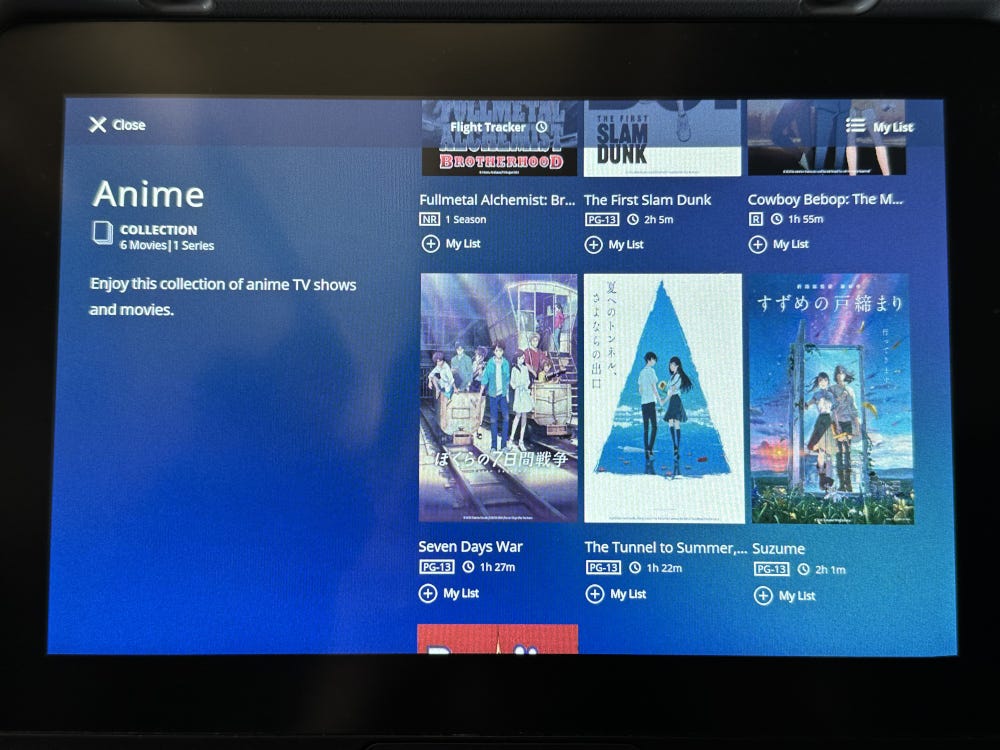Delta Air Lines sends Crunchyroll to the skies
Plus: NTT Docomo spins off AI anime software developer; Sony anime business likened to PlayStation growth phase; Pop Mart enters largest U.S. shopping mall; and more
This is your weekly Animenomics briefing, covering the business of anime and manga. Today is Wednesday, August 13, 2025.
In case you missed it: Crunchyroll laid off an undisclosed number of employees in a restructuring effort that will see the creation of engineering hubs in the United States, Mexico, and India as the company doubles down on growth in emerging markets.
Bloomberg reported in December that Crunchyroll was planning a reorganization this year, making it at least the fourth round of layoffs at the company since it was acquired by Sony and merged with Funimation 2021.
Delta Air Lines in-flight entertainment adds Crunchyroll

Delta Air Lines will add Crunchyroll as a content partner on its Delta Sync in-flight entertainment system, giving passengers of the Atlanta-based global carrier access to more than 2,000 anime titles, reports entertainment news outlet TheWrap.
Why it matters: The deal will make Crunchyroll’s anime library available to up to 120 million members of Delta’s SkyMiles frequent flyer program, the world’s largest airline loyalty program.
Anime had already been available on select Delta flights in the past, but selection was limited and only available on traditional seatback entertainment systems.
How it works: Delta Sync, which requires a SkyMiles membership, allows passengers to use smartphones, tablets, and laptops to access films, television shows, and games from content partners.
Delta Sync users who aren’t already Crunchyroll subscribers will be able to register for the platform and receive a 24-hour trial subscription.
About one-third of Delta’s fleet of more than 900 aircraft also allows passengers to access the Delta Sync experience on seatback screens.
Between the lines: Millennial and Gen Z users—Crunchyroll’s core audience segment—make up 60 percent of passengers who use Delta Sync’s Wi-Fi internet connection, the airline said in February.
Millennials and Gen Z anime fans are less likely to use official streaming services, a recent survey conducted by market research firm National Research Group and commissioned by Crunchyroll found.
By making its library available on Delta Sync, Crunchyroll has an opportunity to convert viewers in its target demographic into new subscribers.
What we’re watching: How much the partnership drives sign-ups for Crunchyroll and converts them into paying subscribers after the trial period.
Delta and Paramount Global signed a similar deal two years ago but have never shared data on Paramount+ sign-ups through Delta Sync since then.
NTT Docomo spins off developer of AI anime software

Japanese mobile phone network operator NTT Docomo has spun off a subsidiary that is developing software incorporating generative artificial intelligence technology into the anime production process.
Why it matters: In demonstrations with multiple anime studios, NTT Docomo says the software named Anicra delivered a 70 percent reduction in man-hours needed to complete certain in-between animation processes.
Zoom in: The Nikkei financial newspaper reports that Anicra is generally available for use by anime studios in their production environments with software’s new operator CrestLab negotiating license cost on a case-by-case basis.
“We plan to introduce this system to a variety of animation productions, including commercial works for television broadcasts and streaming platforms, with the aim of making it the standard production infrastructure for anime production sites,” a statement from NTT Docomo reads.
The intrigue: CrestLab appears to be positioning Anicra as a software that will help anime studios reduce reliance on overseas subcontractors for in-between animation work.
In doing so, anime studios could be insulated from the fluctuating cost of hiring studios outside Japan, saving expenses for other parts of the production process.
Clippings: AI anime startup buys Gainax offshoot studio

Anime startup Creator’s X has acquired anime studio Gaina—founded in 2014 as an independent Gainax offshoot named Fukushima Gainax—from the Kinoshita Group conglomerate and renamed it Benten Film. (Animation Business Journal)
Catch up quick: Creator’s X raised ¥110 million (US$744,000) in December in an effort to produce anime with the assistance of generative artificial intelligence technology, acquiring Nagoya-based anime studio K&K Design in the process.
Bandai Namco Holdings reported a 78 percent year-over-year increase in Gundam series sales in the April–June fiscal quarter, driven by the popularity of the recently aired Mobile Suit Gundam GQuuuuuuX anime series. (Animation Business Journal)
Animator advocacy group Nippon Anime & Film Culture Association will start selling the English-language version of its levels five and six Animator Skills Test textbook this week in the United States. (Press release)
A fictional pirate flag from One Piece has become a symbol of political dissent in Indonesia, where the manga and anime are popular, prompting government threats to penalize Indonesians who wave the flag. (Kompas)
Sony ties Crunchyroll success to anime fandom growth
“Whether we can scale in the same way [as the growth of anime fans] will depend on how interesting the content is and how much excitement we can create among fans. We need to work not only with our own company but also with other IP owners and publishers to understand our fans. [Crunchyroll’s] ability to grow as a platform will depend on how much we can expand our fandom.”
— Toshimoto Mitomo, Sony Group chief strategy officer
Context: Mitomo, who has been involved in Sony’s intellectual property strategy for 40 years, told the Toyo Keizai Online business news portal that he believes the current state of Sony’s anime business is similar to the early days of the PlayStation.
PlayStation’s initial success can be attributed to the popularity of its launch title Ridge Racer, a licensed IP from Namco which was ported from arcade.
It wasn’t until the PlayStation 2 launched in 2000 that Sony began expanding its own video game IPs, cementing its video game business.
What he’s saying: “We believe that the area in our ecosystem where corporate value will increase the most in the future is the distribution side,” Mitomo says, highlighting Sony’s priority of developing Crunchyroll as an anime distributor rather than trying to acquire IP holders like Kadokawa outright.
Sony’s combined anime business of Aniplex and Crunchyroll bring in ¥200 billion (US$1.35 billion), Toyo Keizai estimates, a figure that’s consistent with sales of the original PlayStation a year after its release.
China’s Pop Mart will open in largest U.S. shopping mall
Beijing-based Chinese toy retailer Pop Mart will open a retail branch at the Mall of America later this year, bringing the trendy Labubu line of collectible plush toys to the largest shopping mall in the United States.
Why it matters, personally: Pop Mart is arriving in the Minneapolis–Saint Paul metro area, where Animenomics is based, before any official anime merchandise store from Japan.
What we’re seeing: Anime merchandise and toys found in the region are usually sold by independent retailers or local chains, oftentimes imported by way of a third country like China.
Among iconic Japanese brands, casual wear retailer Uniqlo has no presence in the region, and discount retailer Daiso only made its entry into Minnesota this year.
What we’re watching: Whether Pop Mart’s presence will spark interest among more Asian lifestyle retailers to also open a branch at the Mall of America.
Guangzhou-based lifestyle retailer Miniso is already slated to open a branch at the shopping mall this year.
Animenomics is an independently run and reader-supported publication. If you enjoyed this newsletter, consider sharing it with others.




Whoa! Wasn't aware of Delta Sync at all. Very interesting to see what the results will be. I've been generally happy with Delta's in-flight offerings and partnerships.